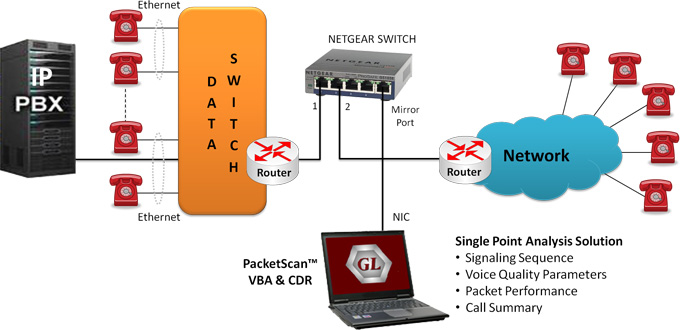Newsletter: GL Enhances PacketScan™ with Unique Triggering and Search Capabilities For "Calls of Interest"
Welcome to the January 2012 issue of GL Communications' Newsletter providing information on the latest enhancements introduced to our PacketScan™ software, an IP/VoIP Analyzer.

Overview
Quality of VoIP service has always been a concern for carriers and service providers who know that being proactive in monitoring voice quality means keeping customers happy. There are free applications such as Wireshark that can be used to capture and listen to u-law and A-law calls. It can also be used to view reports of packet conditions such as packet loss and jitter that degrade quality. While powerful, Wireshark has limitations when being used for general quality monitoring compared to GL's PacketScan™, some of these are listed in the table below:
As a stand-alone tool |
|
As a Single Point Analysis System |
|
As a Probe with Central Monitoring System - PacketScanWeb™ |
|
Supported Codecs |
|
Supported Protocols |
|
QOS Parameters |
|
Traffic handling |
|
Performance Metrics |
|
Triggers and Actions |
|
Important Enhancements
- Search for "Calls of Interest" - To provide a more comprehensive method for analyzing pinpointing quality problems, PacketScan™ has been enhanced to work with GL's VoiceBand Analyzer (VBA) and Call Data Records (CDR) applications to trigger on all calls and generate comprehensive call detail reports along with audio files. The audio files are processed using VBA to measure actual analog voice parameters such as Active Speech Level (ASL), Noise Level, Activity Factor (AF), and RMS power. CDR application uses the per call data from PacketScan™ and VBA analytics to provide useful call detail records for further analysis using Excel®.
- PacketScan™s powerful Triggers and Action feature now includes options to save a set of Call Detail Records for each call containing the signaling, RTP packet statistics, and Mean Opinion Score (MOS) / R-factor scores along with the actual recorded audio file of the call for complete and comprehensive analysis of troubled calls.
- The generated CSV reports from CDR application are analyzed using built in tools included with Excel. The records can be filtered using Advanced Filter in Excel® tool based on signaling, or various measurements to generate reports of "calls of interest". The voice files of these calls can be either downloaded, or played back using Goldwave® or any audio program.
- PacketScan™ can now be configured to automatically start monitoring traffic with filters, trigger actions, and parameters previously saved. This also includes automatically connecting to a remote database for PacketScanWeb™ applications. This can be useful in remote monitoring applications where a laptop can be setup and configured for plug-n-play testing.
Other Enhanced Features Include:
- SIP Performance Metrics
Additional SIP performance metrics have been provided in statistics counters for SIP calls. They are: Session Establishment Ratio, Session Establishment Effective Ratio, Session Defects, Ineffective Session Attempts, Session Completion Ratio, Session Request Delay, and Session Disconnect Delay - Codec
Beyond G.711 u-law and A-law or G.729, the application supports a large number of codecs.
For comprehensive information on these codecs visit " List of Codecs" portion. - Call Summary Tab
In Packet Data Analyzer (PDA is specifically for voice) portion of PacketScan™ a new tab has been added that displays Signaling and Audio Parameters for the selected call (SIP, H323, MEGACO Calls). - Save Call
Save Call feature has been enhanced to save the captured trace along with a PCAP compatible file. - Alert Summary
This feature generates alerts when a particular vital parameter goes beyond a specified value. The user can specify the criteria based on which the alerts are to be generated. The alerts can be set by selecting an option in Alert Summary and in Triggers and Action Settings as well.
Alert Summary tab provides summary of the each alerts that have occurred during the analysis. Each summary has the following columns: Call#, Protocol, Message, Type, Threshold, Value, Caller, Callee, CallId. - T.38 Analysis
T.38 has been enhanced to reassemble and identify the T.30 message from the fragmented messages that constitute the fax image and signaling data. Once identified the T.30 message is displayed in a T.38 ladder diagram. - VQMon Setting
VQMon Setting is enhanced with an option to select the Japan or North America International standard code. These standards are followed in calculating MOS scores based upon R-Factor scores.
For comprehensive information on PacketScan™ and other applications, please refer to our PacketScan™ webpage, and web pages on CDR, VBA, PacketProbe™, and PacketScanWeb™.
 Back to Newsletter Index Page
Back to Newsletter Index Page